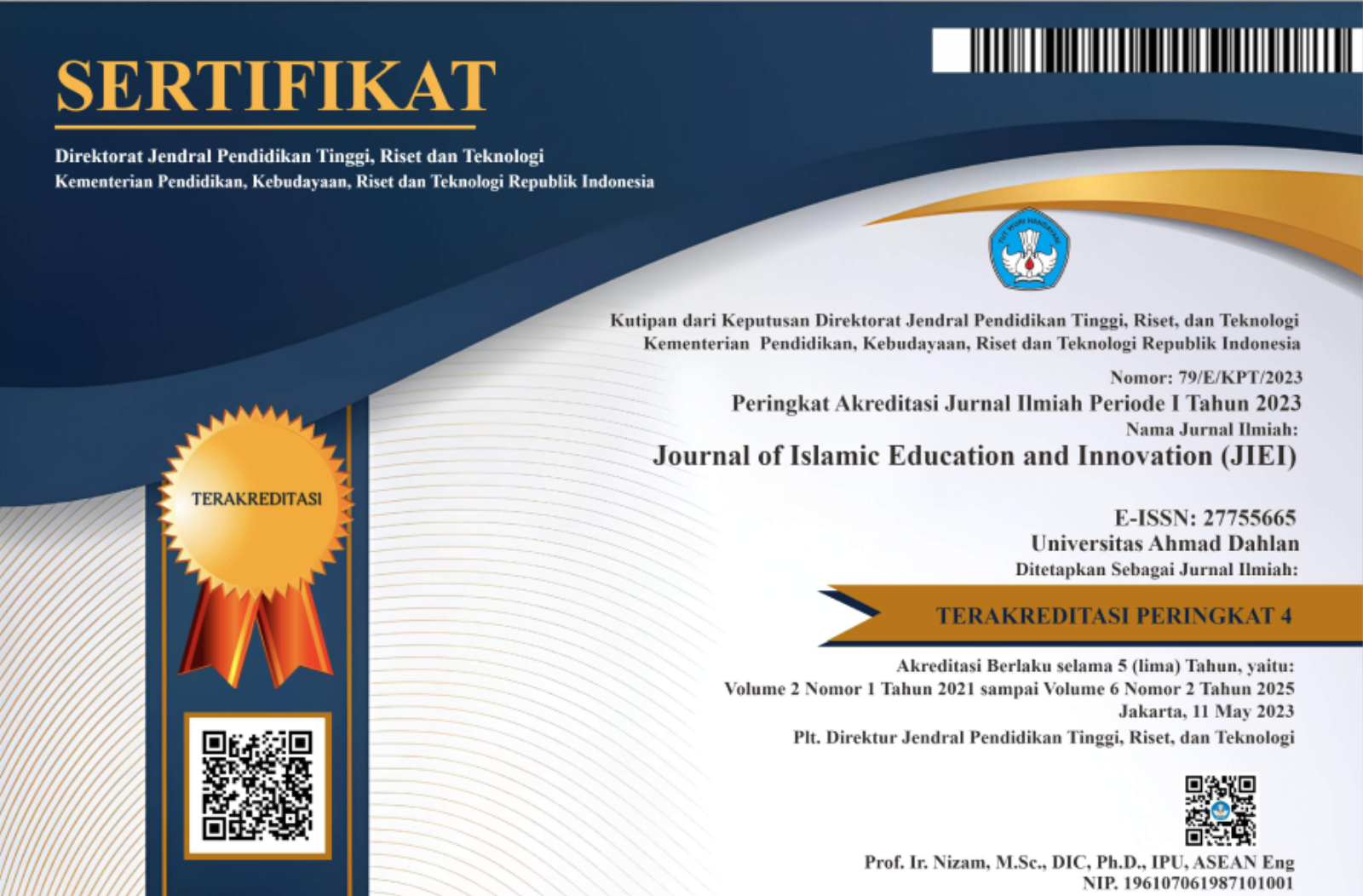(Ø£Ùكار ابن تيمية وتØديات التربية الإسلامية اليوم (دراسة تØليلية نوعية وصÙية
DOI:
https://doi.org/10.26555/jiei.v2i1.3859Keywords:
التربية الإسلامية، ابن تيمية، التØدياتAbstract
التربية الإسلامية هي المصدرالرئيس ÙÙŠ Øياة المسلمين. ووجودÙها من أجل زيادة القدرة على الجمع بين الروØانية والعملية وتشكيل مسلم مخلص لله سبØانه وتعالى، تكÙون له شخصية نبيلة. ÙÙŠ العصراليوم، هناك الكثير من التØديات التي تواجه التربية الإسلامية، لاسيما المتعلقة بالعولمة والتطورات التكنولوجية، وكذلك تأثير الثقاÙØ© الغربية. وإن الغرض من هذا البØØ« إيجاد Øلول للتØديات الØالية ÙÙŠ التربية الإسلامية من Ø£Ùكارابن تيمية. كان ابن تيمية Ø£Øد الÙلاسÙØ© المسلمين، واهتم بالتربية الإسلامية اهتماماً كبيراً. وقال كلاماً كثيراً عن التربية الإسلامية، وقال إنه لايمكن ØÙ„ جميع المشاكل التي يواجهها المسلم إلَّا بالتربية الإسلامية. استخدم هذاالبØØ« المنهج النوعي الوصÙÙ‰. والبيانات من الأدبيات الموجودة، ثم تمَّ تØليل البيانات وصÙياً، أي عن طريق جمع البيانات وتصنيÙها ثم معالجتها. وتشير نتائج هذا البØØ« إلى أن ابن تيمية قدم عدة Øلول ÙÙŠ مواجهة تØديات التربية الإسلامية المختلÙØ©ØŒ على الرغم من أن التØديات التى واجهتها ليست واØدة بسبب الÙترات الزمنية المختلÙØ©. ويمكن استخدام هذه الØلول ÙÙŠ أي وقت لأنها تركزعلى شخصية كل مسلم.
References
[2] A. T. A. Putra, “Pemikiran Filosofis Pendidikan Ibnu Sina,†Lliterasi, vol. VI, no. 2, pp. 191–201, 2015.
[3] D. Ilham, “The Challenge of Islamic Education and How to Change,†Int. J. Asian Educ., vol. 1, no. 1, pp. 15–20, 2020, doi: 10.46966/ijae.v1i1.16.
[4] E. K. Poerwandari, Pendekatan Kualitatif Untuk Penelitian Perilaku Manusia. Depok: LPSP3 Universitas Indonesia, 2005.
[5] Sugiyono, Metode Penelitian Kuantitatif, Kualitatif dan R&D. Bandung: Alfabeta, 2013.
[6] Ù…. Ù…. الجراØ, أصول البØØ« العلمي. عمان: دار الراية للنشر والتوزيع, 2014.
[7] N. S. Sukmadinata, Metode Penelitian Pendidikan. Bandung: Remaja Rosda Karya, 2011.
[8] ع. ب. س. القØطانى, “معيار Ù…Ù‚ØªØ±Ø Ù„ØªØكيم البØوث النوعية ÙÙŠ المناهج وطرق التدريس,†مجلة العلوم التربوية, vol. 4, no. 3, pp. 14–17, 2018.
[9] L. J. Moleong, Metode Penelitian Kualitatif, 36th ed. Bandung: Remaja Rosda Karya, 2017.
[10] Ø£. Ø. Ø£. الÙقيه, “تصميم البØØ« النوعي ÙÙŠ المجال التربوي مع التركيز على بØوث تعليم اللغة العربية,†Int. J. Educ. Psychol. Stud., vol. 2, no. 3, pp. 354–368, 2017.
[11] Matthew B. Miles and A. M. Huberman, Qualitative Data Analysis, 2nd ed. California: SAGE Publications, 1994.
[12] ع. ا. النØلاوي, ابن تيمية. دمشق: دار الÙكر, 1986.
[13] Ù…. ب. ع. ا. العريÙÙŠ, زÙبدَة الÙوائد من كتب ابن تيمية. الرياض: دار التدمرية, 2009.
[14] ا. تيمية, العبودية. الاسماعيلية: دار الأصالة, 1999.
[15] Ø£. ا. ع. ا. ا. تيمية, مجموع الÙتاوى لشيخ الإسلام, 3rd ed. المنصورية: دار الوÙاء, 2005.
[16] ص. ع. ا. Ù…. ع. النبي, الاتجاهات الØديثة للمناهج ÙÙŠ التراث العربي الإسلامي. القاهرة: مطبعة جامعة القاهرة, 2018.
[17] Ø¥. Ù…. العَلي, شيخ الإسلام Ø£Øمد بن تيمية رجل Ø§Ù„Ø¥ØµÙ„Ø§Ø ÙˆØ§Ù„Ø¯Ø¹ÙˆØ©. دمشق: دار القلم, 2000.
[18] Ù…. Ø. الزين, منطق ابن تيمية ومنهجه الÙكري. بيروت: المكتب الإسلامي, 1979.
[19] Ù. ر. Ø£. خيَّاط, الأهدا٠التربوية السلوكية عند شيخ الإسلام ابن تيمية. مكة المكرمة: مكتبة المنارة, 1987.
[20] M. A. H. Ansari, Ibn Taymiyyah Expounds on Islam. Doha: Dar al Thaqafah, 1999.
[21] Ù…. ب. ع. ا. المغراوي, المÙسرين بين التأويل والإثبات ÙÙŠ آيات الصÙات. بيروت: مؤسسة الرسالة, 2000.
[22] Ù…. ع. الكيلاني, الÙكر التربوي عند ابن تيمية. المدينة: دار التراث, 1986.
[23] ع. ب. ع. ا. س. الجلال, “مقارنة بعض آراء ابن تيمية ÙÙŠ التربية والتعليم بأسس التربية الإسلامية,†مجلة التربية, vol. 143, no. 3, pp. 177–211, 2009.
[24] Ø£. ا. ع. ا. ا. تيمية, درء تعارض العقل والنقل. رياض: جامعة الإمام Ù…Øمد بن سعود الإسلامية, 1991.
[25] Ù…. ا. الجليند, دَرْء تعارÙض العقل والنقل. القاهرة: مركز الأهرام, 1988.
[26] Ø£. ا. ع. ا. ا. تيمية, Ø´Ø±Ø Ø§Ù„Ø£ØµØ¨Ù‡Ø§Ù†ÙŠØ©. رياض: دار المنهاج, 2010.
[27] M. N. S. Syah, “Challenges of Islamic Education in Muslimworld : Historical , Political , and Socio-Cultural Perspective,†QIJIS Qudus Int. J. Islam. Stud., vol. 4, no. 1, 2016, [Online]. Available: http://journal.stainkudus.ac.id/index.php/QIJIS/article/download/1580/1449.
Downloads
Published
Versions
- 2021-06-30 (2)
- 2021-05-04 (1)
Issue
Section
License
License and Copyright Agreement
In submitting the manuscript to the journal, the authors certify that:
- They are authorized by their co-authors to enter into these arrangements.
- The work described has not been formally published before, except in the form of an abstract or as part of a published lecture, review, thesis, or overlay journal. Please also carefully read the International JIEI Author Guidelines at http://journal2.uad.ac.id/index.php/jiei/about/submissions#onlineSubmissions
- That it is not under consideration for publication elsewhere,
- That its publication has been approved by all the author(s) and by the responsible authorities “ tacitly or explicitly “ of the institutes where the work has been carried out.
- They secure the right to reproduce any material that has already been published or copyrighted elsewhere.
- They agree to the following license and copyright agreement.
Copyright
Authors who publish with the Journal of Islamic Education and Innovation agree to the following terms:
- Authors retain copyright and grant the journal right of first publication with the work simultaneously licensed under a Creative Commons Attribution License (CC BY-SA 4.0) that allows others to share the work with an acknowledgment of the work's authorship and initial publication in this journal.
- Authors are able to enter into separate, additional contractual arrangements for the non-exclusive distribution of the journal's published version of the work (e.g., post it to an institutional repository or publish it in a book), with an acknowledgment of its initial publication in this journal.
- Authors are permitted and encouraged to post their work online (e.g., in institutional repositories or on their website) prior to and during the submission process, as it can lead to productive exchanges, as well as earlier and greater citation of published work.









